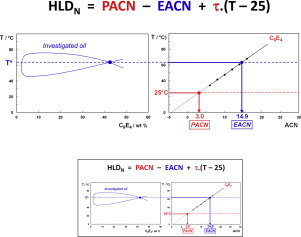当前位置:
X-MOL 学术
›
Adv. Colloid Interface Sci.
›
论文详情
Our official English website, www.x-mol.net, welcomes your feedback! (Note: you will need to create a separate account there.)
Use of the normalized hydrophilic-lipophilic-deviation (HLDN) equation for determining the equivalent alkane carbon number (EACN) of oils and the preferred alkane carbon number (PACN) of nonionic surfactants by the fish-tail method (FTM).
Advances in Colloid and Interface Science ( IF 15.6 ) Pub Date : 2019-12-30 , DOI: 10.1016/j.cis.2019.102099 Jean-Marie Aubry 1 , Jesús F Ontiveros 1 , Jean-Louis Salager 2 , Véronique Nardello-Rataj 1
Advances in Colloid and Interface Science ( IF 15.6 ) Pub Date : 2019-12-30 , DOI: 10.1016/j.cis.2019.102099 Jean-Marie Aubry 1 , Jesús F Ontiveros 1 , Jean-Louis Salager 2 , Véronique Nardello-Rataj 1
Affiliation

|
The standard HLD (Hydrophilic-Lipophilic-Deviation) equation expressing quantitatively the deviation from the "optimum formulation" of Surfactant/Oil/Water systems is normalized and simplified into a relation including only the three more meaningful formulation variables, namely (i) the "Preferred Alkane Carbon Number" PACN which expresses the amphiphilicity of the surfactant, (ii) the "Equivalent Alkane Carbon Number" EACN which accurately reflects the hydrophobicity of the oil and (iii) the temperature which has a strong influence on ethoxylated surfactants and is thus selected as an effective, continuous and reversible scanning variable. The PACN and EACN values, as well as the "temperature-sensitivity-coefficient"τ of surfactants are determined by reviewing available data in the literature for 17 nonionic n-alkyl polyglycol ether (CiEj) surfactants and 125 well-defined oils. The key information used is the so-called "fish-tail-temperature" T* which is a unique data point in true ternary CiEj/Oil/Water fish diagrams. The PACNs of CiEj surfactants are compared with other descriptors of their amphiphilicity, namely, the cloud point, the HLB number and the PIT-slope value. The EACNs of oils are rationalized by the Effective-Packing-Parameter concept and modelled thanks to the COSMO-RS theory.
中文翻译:

通过鱼尾法(FTM)使用归一化亲水-亲脂偏差(HLDN)方程确定油的当量烷烃碳数(EACN)和非离子表面活性剂的优选烷烃碳数(PACN)。
定量表示表面活性剂/油/水系统的“最佳配方”偏差的标准HLD(亲水性-亲脂性偏差)方程式已标准化并简化为仅包含三个更有意义的配方变量的关系,即(i)“表示表面活性剂两亲性的优选的“烷烃碳数” PACN,(ii)精确反映油的疏水性的“当量烷烃碳数” EACN,以及(iii)对乙氧基化表面活性剂有强烈影响的温度选择作为有效,连续和可逆的扫描变量。PACN和EACN值,以及“温度敏感性系数” 表面活性剂的τ是通过查阅文献中17种非离子正烷基聚乙二醇醚(CiEj)表面活性剂和125种定义明确的油的数据确定的。使用的关键信息是所谓的“鱼尾温度” T *,它是真实三元CiEj /油/水鱼图中的唯一数据点。将CiEj表面活性剂的PACN与两亲性的其他描述子进行比较,即浊点,HLB数和PIT斜率值。通过有效包装参数概念对油的EACN进行了合理化,并借助COSMO-RS理论对油的EACN进行了建模。将CiEj表面活性剂的PACN与两亲性的其他描述子进行比较,即浊点,HLB数和PIT斜率值。通过有效包装参数概念合理化了油的EACN,并借助COSMO-RS理论对油的EACN进行了建模。将CiEj表面活性剂的PACN与两亲性的其他描述子进行比较,即浊点,HLB数和PIT斜率值。通过有效包装参数概念合理化了油的EACN,并借助COSMO-RS理论对油的EACN进行了建模。
更新日期:2019-12-30
中文翻译:

通过鱼尾法(FTM)使用归一化亲水-亲脂偏差(HLDN)方程确定油的当量烷烃碳数(EACN)和非离子表面活性剂的优选烷烃碳数(PACN)。
定量表示表面活性剂/油/水系统的“最佳配方”偏差的标准HLD(亲水性-亲脂性偏差)方程式已标准化并简化为仅包含三个更有意义的配方变量的关系,即(i)“表示表面活性剂两亲性的优选的“烷烃碳数” PACN,(ii)精确反映油的疏水性的“当量烷烃碳数” EACN,以及(iii)对乙氧基化表面活性剂有强烈影响的温度选择作为有效,连续和可逆的扫描变量。PACN和EACN值,以及“温度敏感性系数” 表面活性剂的τ是通过查阅文献中17种非离子正烷基聚乙二醇醚(CiEj)表面活性剂和125种定义明确的油的数据确定的。使用的关键信息是所谓的“鱼尾温度” T *,它是真实三元CiEj /油/水鱼图中的唯一数据点。将CiEj表面活性剂的PACN与两亲性的其他描述子进行比较,即浊点,HLB数和PIT斜率值。通过有效包装参数概念对油的EACN进行了合理化,并借助COSMO-RS理论对油的EACN进行了建模。将CiEj表面活性剂的PACN与两亲性的其他描述子进行比较,即浊点,HLB数和PIT斜率值。通过有效包装参数概念合理化了油的EACN,并借助COSMO-RS理论对油的EACN进行了建模。将CiEj表面活性剂的PACN与两亲性的其他描述子进行比较,即浊点,HLB数和PIT斜率值。通过有效包装参数概念合理化了油的EACN,并借助COSMO-RS理论对油的EACN进行了建模。

























 京公网安备 11010802027423号
京公网安备 11010802027423号